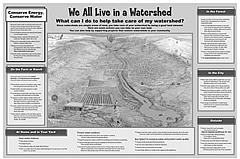Know Your Watershed – It’s Where Your Water Comes From!
What is a Watershed?
A watershed is a region of land that drains to a particular body of water such as a river or a lake. Rain or snow that falls anywhere in that watershed eventually flows to that water body. It may travel overland as surface water or flow underground as groundwater
Learn more about southwestern watersheds.
|
||
 |
 |
|
Know Your Watershed
|
||
 |
||
To request a copy of the poster contact Susan Rich at New Mexico State Forestry.
Why are watersheds important?
Watersheds are the source of all the water we use. Water enters the watershed as rain or snowmelt in the highlands. It soaks into the ground to replenish aquifers and gathers in ponds and creeks that feed larger streams and rivers. A healthy watershed acts like a sponge, absorbing, storing, and slowly releasing water.
We all live in a watershed. Where is YOUR watershed?
When it rains or snows at your home, that water eventually drains down to an arroyo, river, lake or other water body. All of the land that drains to that particular body of water is your watershed. The boundaries of your watershed are the drainage divides – the high places that separate the waters that drain into your watershed from those that drain to different watersheds.
What can I do to help take care of my watershed?
Since watersheds are simply areas of land, you take care of your watershed by being a good land steward. There are many ways you can help.
- Managing Arid and Semi-arid Watersheds
- Science in Your Watershed “Information Discovery” pages (USGS)
- Adopt-A-Watershed (US EPA)
Educational resources about watersheds
- General Links
- River Exchange Program
- “What is a Watershed?” Lesson plans
- 'Rio! the Water Detective' and More
- Managing Arid and Semi-Arid Watersheds: Resources for Kids and Educators








